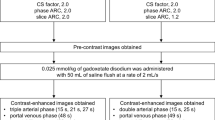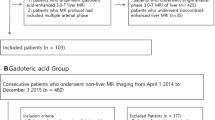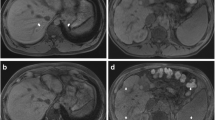Abstract
The goal of our prospective study was to compare quantitatively and qualitatively in-phase and opposed-phase T1-weighted breath-hold spoiled gradient-recalled-echo (GRE) MR imaging technique for imaging focal hepatic lesion. Thirty-eight patients with 53 focal hepatic lesions had in-phase (TR = 12.3 ms, TE = 4.2 ms) and opposed-phase (TR = 10.1 ms, TE = 1.9 ms) GRE (flip angle = 30°, bandwidth ± 32 kHz, matrix size 256 × 128, one signal average) MR imaging at 1.5 T. Images were analyzed quantitatively by measuring the lesion-to-liver contrast and for lesion detection. In addition, images were reviewed qualitatively for lesion conspicuity. Quantitatively, lesion-to-liver contrast obtained with in-phase (3.22 ± 1.86) and opposed-phase pulse sequence (3.72 ± 2.32) were not statistically different (Student's t-test). No difference in sensitivity was found between in-phase and opposed-phase pulse sequence (31 of 53, sensitivity 58 % vs 30 of 53, sensitivity 57 %, respectively). Two lesions not seen with opposed-phase imaging were detected with in-phase imaging. Conversely, one lesion not seen on in-phase imaging was detected on opposed-phase imaging so that the combination of in-phase and opposed-phase imaging yielded detection of 32 of 53 lesions (sensitivity 60 %). Qualitatively, lesion conspicuity was similar with both techniques. However, in-phase images showed better lesion conspicuity than opposed-phase images in 9 cases, and opposed-phase images showed better lesion conspicuity than in-phase images in 7 cases. No definite advantage (at a significant level) emerged between in-phase and opposed-phase spoiled GRE imaging. Because differences in lesion conspicuity and lesion detection may be observed with the two techniques in individual cases, MR evaluation of patients with focal hepatic lesion should include both in-phase and opposed-phase spoiled GRE imaging.
Similar content being viewed by others
Author information
Authors and Affiliations
Additional information
Received 30 October 1996; Revision received 6 January 1997; Accepted 8 January 1997
Rights and permissions
About this article
Cite this article
Soyer, P., Rondeau, Y., Dufresne, AC. et al. T1-weighted spoiled gradient-echo MR imaging of focal hepatic lesion: comparison of in-phase vs opposed-phase pulse sequence. Eur Radiol 7, 1048–1053 (1997). https://doi.org/10.1007/s003300050250
Published:
Issue Date:
DOI: https://doi.org/10.1007/s003300050250




